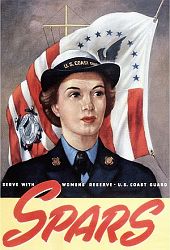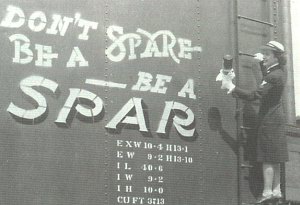Strength of the SPARS
.
During planning sessions in 1942, the Coast
Guard first estimated its requirements for female personnel. At that time,
it was hoped that SPAR strength would reach a total of 400 female officers
and 8,000 enlisted women within two years, by April 1944.
.
| Women found the allure of Coast Guard duty
popular, although the primary combat attraction for American women in World
War II remained as nurses, a field that the SPARS did not include.
This was because the Coast Guard acquired its combatant nurses directly
from the commissioned corps of the Public Health
Service .
Nevertheless, only 60 days after the SPARS
program was first authorized, 531 women had enlisted and 121 of them had
received full commissions as officers. Recruitment progress continued and
the SPARS reached strength of 333 officers and 2,838 enlisted women by
May 1943. |
.v |
 |
.
 |
.v |
The highly selective US Coast Guard paid careful
attention to the total feminine qualities of potential woman recruits.
Most women who tried to join the SPARS did not meet such exacting high
standards.
Wartime records show that tens of thousands
applied, but only 11,558 female applicants were found qualified during
twelve months from June 1943 until July 1944.
Even these highly qualified women had to endure
a further difficult screening process that also considered their backgrounds
and boating experience.
Therefore, of these nearly 12,000 applicants
only 62 percent were actually accepted for Coast Guard duty. 5,020 of these
women, or about three-fourths of those invited to join, finally enlisted
as Coast Guard recruits. |
.
Although this number met the first planned
Coast Guard needs, District Coast Guard land offices demanded many more
women personnel. They were needed to free Coast Guardsmen for sea duty
and overseas assignment.
.
The Coast Guard shore establishment found
that it took 1.13 Coast Guard people to support each man actually deployed
at sea.
To insure that this ratio was achieved, the
Coast Guard requested an 81 percent increase in additional SPAR personnel
at the end of 1943.
This remarkable request documents both the
high value of the SPARS contribution, and how well the women's reserve
was meeting all expectations. |
.. |
 SPAR Petty Officer christening
a boxcar which bears the recruiting slogan "Don't be a Spare - be a SPAR"
SPAR Petty Officer christening
a boxcar which bears the recruiting slogan "Don't be a Spare - be a SPAR"
|
.
 SPARS rowing a boat with
SPARS rowing a boat with
Coast Guardsman as coxswain
|
.. |
In December 1943, the US Coast Guard announced
that it was boosting requirements to 1,200 female officers and 12,000 female
enlisted, at a time when there were 489 women officers and 6,103 women
enlisted personnel on active duty.
By D-Day on 6 June 1944, when the Allies invaded
German-held France, the SPARS contained 771 officers and 7,600 enlisted
servicewomen. Furthermore, the Coast Guard's medical service was already
composed of Public Health Service nurses and even female PHS medical officers
on direct combat and shipboard assignments. |
.
| As of the June 1945, when the Coast Guard
had reached a peak strength of 171,168 members (compared to about 29,000
on 7 December 1941 when Pearl Harbor was attacked), 80,476 were actually
aboard warships and other vessels.
The SPARS and Coast Guard Temporary Reservists
were responsible for allowing the deployment of so many men for the fighting
front. The Coast Guard mission in World War II was accomplished thanks
in large measure to the strength of the SPARS complement and other women
who supplemented the male ranks. |
..v |

SPAR repairing a motor
|
.
 |
.v |
In August 1945, the demobilization of the
Coast Guard Reserve personnel began and was nearly completed by the middle
of 1946. In July 1947, the last SPARS were discharged when Congress terminated
the emergency Coast Guard legislation.
In 1948, the Women's Armed Services Integration
established both a regular and reserve status for women in the Army, Navy,
Marine Corps and Air Force. The Coast Guard was not covered by this legislation,
but finally its Women's Reserve was re-established and a regular women's
corps authorized in 1949. Many former SPARS joined the Regular and Reserve
Corps. |
.
.
[ I. Development ]..[
II. Facts about the SPARS ]..[
III. Uniforms ]..[
IV. Sources ]
|
